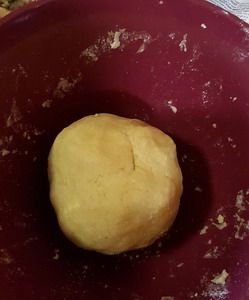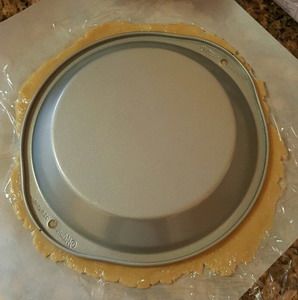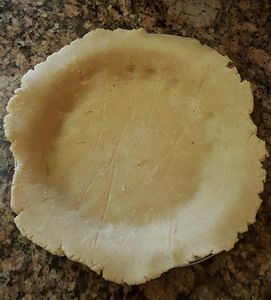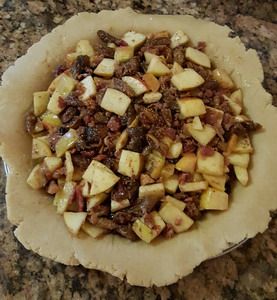
Creation according to my son: In the beginning God created man and provided him with the bounty of the earth to sustain him and God was pleased. Man wandered in the garden and partook of the fruits and vegetables and life was good. But man felt an emptiness and a deep hunger for something more. Man beseeched God to name this hunger and satisfy it. God looked deep into man’s soul and found that his creation indeed had a need that the man could not fill with his skills at relating to the garden God had provided. So God in his infinite love and mercy created woman, who had the skills to meet the deep need within man – the need for pie. Woman understood about cycles for planting and cycles for harvesting the sacred ingredients that were needed for the making of pie. And in her love and kindness woman made pie for man and man’s life was now complete.

Pie certainly meets deep needs within every man’s heart. It comes in so many varieties – from fruit pies and cream pies to custard and meat pies. Pies were the first hand-held fast food – popular at festivals and gatherings. In early times pies were mostly savory in flavor and filled with meats, fats, herbs, and spices. Vegetable pies that were the forerunners of our modern pumpkin pies were also popular. Sweet pies came out of a need to preserve the contents of the pies, as honey, the only commonly available sweet in olden times was also a great preservative. In fact the early ancestor of the pie was the galette, which was a rough crusty cake of oats or rye with a dollop of honey in the middle as a treat. Records of these treats can be found on the tomb walls of pharaoh Ramesses II of Egypt. The Greeks are believed to be the first to create the pastry crust that we think of as defining the true pie. Records dating back to the 5th century BC discuss the use of sweetmeats and fruit-filled pastries consumed at feasts.

To truly appreciate the deeper meaning of pie to the western world, you must grasp that the sandwich was not invented until the 18th century. So wrapping your meal in a bread like container in order to keep your hands cleaner, not to mention the food a lot cleaner, fell to the power of the pie crust. Cooking a meal into a crust helped to preserve the food and enable it to be transported much more easily. The traditional crust was made from a ground grain flour and animal fat. Both are very stable and do not spoil easily, thus protecting the meats, vegetables, or fruits inside. The baking of the pies sterilized the contents inside and the crust served much the same function as an airtight edible wrapper – a vital concern in an era where refrigeration had not yet been invented.

Pies have developed in a huge variety of forms to meet the needs of the local peoples. Everything from puff pastries wrapped around huge cuts of meat or fowl to retain the juiciness of the meat were common, as were small hand-held meals used by common workers, such as in the Cornish pasty. Improvements in food preservation have resulted in the decline of the pie since the near universal use of pies in days gone by. In America today the most common pie still consumed, other than traditional pies at Thanksgiving, is the pizza pie. We here in the West have lost the understanding that pizza is actually a pie, but back East they still refer to pizzas as pies. Like festive pies of old meant to be eaten immediately, pizza pie is an open face pie – no enclosing top crust. But any way you cut it, a pie is a pie is a pie.

When I first started researching for this article a month ago, I contacted the gourmet chef at the Elliott’s Nutrition on El Camino, Cynthia Elliott. I was seeking her assistance on how to prepare a good gluten free pie crust. The two ready-made gluten free pie crusts from the grocery store I have tried were really terrible. So I needed a secret recipe from a real chef to make pies for Thanksgiving. Here is the recipe she gave me: Basic No Fail Pie Crust1 ¾ C Brown Rice Flour Mix¼ C Sweet Rice Flour¼ C Coconut Sugar1 tsp. Xanthan Gum ½ tsp. Salt12 Tbs. Butter2 Eggs 2 Tbs. Lemon Juice

Use a standing mixer or food processor to blend the dry ingredients.Add the butter and process until it forms small pieces – or go old school like I did with a pastry blender.Add the egg and lemon juice and mix until it comes together. Form into a ball and refrigerate to harden, if necessary, before rolling out. She also included the ingredients for the brown rice flour mix:6 C Brown Rice Flour2 C Potato Starch1 C Tapioca Flour

Cynthia said these recipes are from Cooks Illustrated Gluten Free Cook Book.The recipe arrived the day before I needed to make the pies and I did not have all the ingredients, so I made a couple substitutions which worked out fine. For the flours I substituted Pamela’s Gluten Free Baking Mix. I used my Dr Dave’s Sugar Substitute for the coconut sugar, and I used Smart Balance Organic for the butter. The recipe makes a good crust for a typical 2 crust 8 inch pie. I would increase the recipe amounts by one quarter for a 9 or 10 inch pie.

A big key to making pie crusts easily is to roll out the crusts between plastic wrap or wax paper on top and wax paper or parchment underneath. I prefer using a sheet of parchment paper under the dough as it can hold up to the weight of the crust. Put your ball of dough (1/2 of the dough ball you made with the recipe) in the middle of the parchment paper and place another large sheet of plastic wrap over the top. Roll out the dough with a rolling pin rolling over the plastic wrap. This keeps the rolling pin clean and allows the crust

to roll out without sticking to the roller. That was always the frustrating part when I was young; the crust always broke because the dough stuck to the roller. Roll it out into a circle about 1 inch larger than the pie tin you are going to use. This way you’ll have an overhang with which to pinch the crust top to the bottom crust together.

Slip you hand under the parchment paper under the crust and flip the crust into the pie tin. If you are making a fruit pie or a savory pie, then put your filling into the pie tin and roll out a top crust and pop it over the filling. Pinch your edges together to seal the filling into the crust and cut a few air slits into the top crust to allow steam to escape.

If you are making a cream or custard pie then poke a bunch of holes into the crust bottom with a fork and bake the crust until golden brown before you put your filling into the pie crust. Here you have enough dough for two pies, since you are not going to put a crust on top.

This is just an intro into the ancient and sacred art of pie making. It is not really very difficult and will open up a whole new world of real food cooking for you that will touch the very souls of those around you. Nothing says love like a freshly baked pie.
